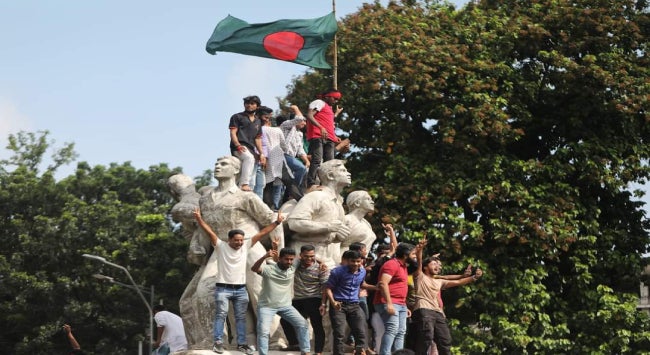Summary
The political violence in Bangladesh cannot be read in isolation. It is the product of years of political repression by the Sheikh Hasina government. With Hasina fleeing the country and the Bangladesh Army likely to form an interim government, it will be interesting to see how the current political landscape unfolds.
Bangladesh is in the midst of severe violence. Hundreds of the country’s citizens have lost their lives. The protests began soon after the 5 June 2024 judgement by the High Court, in which it reinstated the 30 per cent quota for descendants of war veterans who fought against the Pakistani establishment in 1971 to liberate the country. The judgment also maintained the quota for the other weaker section of the country’s population. The university students mainly led the protest against this judgement.
The quota system was first introduced in Bangladesh in 1972 by Sheikh Mujibur Rahman. For many critics of the system, it unfairly benefits pro-government families. In 2018, Sheikh Hasina’s government abolished the reservations following protests. In its June 2024 judgement, the High Court reinstated the quota deeming its abolition illegal. The government appealed against the decision. The Appellate Division maintained a status quo on the High Court’s decision. Later, the Supreme Court, in its judgement on 21 July 2024, directed that 93 per cent of government jobs should be based on merit, five per cent to be reserved for the descendants of war veterans and two per cent reserved for members of the ethnic minorities, transgenders and disabled people. The student groups welcomed the judgement but decided to continue their demonstrations until their key demands, including the release of those jailed and the resignations of the officials responsible for using violence, are accepted by the government.
In dealing with the protests, Hasina seemed to forget the country’s history. Bangladesh was primarily the product of the students’ struggle. In 1948, 1952, 1960s and 1971, the students fought against the Pakistani establishment for the rights of the citizens. In 1971, the Pakistan Army’s early target, under ‘Operation Searchlight’, was Dhaka University’s hostels, fully realising the power of the students. When confronted by the students’ protests and demands, instead of addressing their issues and the growing political disenchantment, Hasina tried to delegitimise the protestors by demonising them as Razakars (militia who supported the Pakistan Army during the 1971 Liberation War). Hasina retorted, “If the grandchildren of the freedom fighters don’t get quota benefits, should the grandchildren of Razakars get the benefit?” However, such labelling did little to break the protestor’s resolve and they remained defiant.
The protests cannot be read in isolation from the larger political developments in Bangladesh under Hasina’s rule. Once considered a hope for Bangladesh’s democracy in the late 1980s and early 1990s, Hasina has been labelled an ‘authoritarian’ leader. She has been accused of stifling individual civic rights and on cracking down on freedom of expression. As widely reported by international human rights organisations, her government also engaged in extrajudicial killings, enforced disappearances and the use of other forms to torture against dissenters and critics.
In January 2024, Hasina was accused of using unfair means to win the elections. During the election period, around 25,000 opposition leaders and supporters were arrested. Some were tortured and denied treatment. Even the voter turnout was said to be manipulated. The Chief Election Commissioner of Bangladesh, Kazi Habibul Awal, initially noted that the voter turnout was 28 per cent but, within an hour, the figures were changed to 40 per cent. Even the 28 per cent is considered by many as an ‘inflated’ figure. Twenty-six parties, mainly the smaller ones, out of the 44 registered political parties, contested the polls. The Bangladesh Nationalist Party (BNP), a major Awami League (AL) opponent, boycotted the elections. The AL won 222 out of 300 parliamentary seats, independent candidates 63 seats and the Jatiya Party 11 seats during the elections. This was not done for the first time that Hasina has been accused of meddling with the elections. It was alleged that the Hasina government also manipulated the 2014 and 2018 elections.
The decline in democracy in Bangladesh had been largely masked by a significant turnaround of the country’s economy under Hasina’s leadership. Bangladesh’s gross domestic product registered a growth of 5.82 per cent in 2023 and is expected to grow at 6.6 per cent in 2025. Bangladesh is also set to graduate from the category of the least developed countries and it will officially become a developing country by the end of 2026. As a result of its impressive economic growth, Bangladesh has been viewed as a model for many small economies of the world.
The political upheaval resulting from the protests against the Hasina government is not a sudden and abrupt occurrence. Rather, it is the result of suppressed political grievances of many Bangladeshis over the years. Hasina has fled the country and the Bangladesh Army is likely to form an interim government. It will be interesting to see what directions the country’s politics are likely to take. Hasina’s resignation may be considered a big victory for the protestors but the Bangladesh Army assuming political power is not a long-term solution to the grievances of the people.
. . . . .
Dr Amit Ranjan is a Research Fellow at the Institute of South Asian Studies (ISAS), an autonomous research institute at the National University of Singapore (NUS). He can be contacted at isasar@nus.edu.sg. The author bears full responsibility for the facts cited and opinions expressed in this paper.
Pic Credit: Twitter
-
 More From :
More From :
-
 Tags :
Tags :
-
 Download PDF
Download PDF



